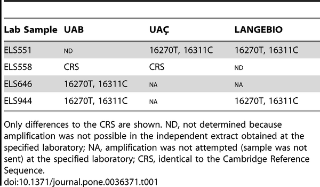slothisticated:Neonate Human Remains: A Window of Opportunity to the Molecular Study of Ancient Sy
slothisticated: Neonate Human Remains: A Window of Opportunity to the Molecular Study of Ancient Syphilis Abstract Ancient DNA (aDNA) analysis can be a useful tool in bacterial disease diagnosis in human remains. However, while the recovery of Mycobacterium spp. has been widely successful, several authors report unsuccessful results regarding ancient treponemal DNA, casting doubts on the usefulness of this technique for the diagnosis of ancient syphilis. Here, we present results from an analysis of four newborn specimens recovered from the crypt of “La Ermita de la Soledad” (XVI–XVII centuries), located in the province of Huelva in the southwest of Spain. We extracted and analyzed aDNA in three independent laboratories, following specific procedures generally practiced in the aDNA field, including cloning of the amplified DNA fragments and sequencing of several clones. This is the most ancient case, reported to date, from which detection of DNA from T. pallidum subspecies pallidum has been successful in more than one individual, and we put forward a hypothesis to explain this result, taking into account the course of the disease in neonate individuals. Introduction Syphilis was the most important chronic infectious disease that spread in Europe in the late 15th and early 16th centuries. Historical chroniclers relate that in March 1493 Columbus returned in triumph to the royal court in Barcelona, and while a second voyage was being prepared, a strange affliction broke out in the city. Everything indicated that, with the discovery of America in 1492, Columbus’s sailors were infected there, and brought the disease back into Europe [1]. However, according to different scholars, syphilis appeared for the first time in Europe in 1493, in March in Rome, or in February in Naples [1]. Then, the period of time between the discovery of America and the outbreak of the epidemic, seems to be non tenable for developing the epidemic. In spite of the many publications on its origin, this issue is far from being resolved. While some authors claim a lack of evidence for syphilis in the Old World before the voyages of Columbus [2], a minority contend that syphilis occurred in Europe before the Christian Era [3], and some others find ancient bone remains that prove its ancient presence in Europe [4]–[8]. However, morphology-based diagnosis of treponemal disease in skeletal remains is not always reliable, and differentiating between different treponematoses, or even other entities such as leprosy, is very difficult. Ancient DNA (aDNA) analysis can be a useful tool in bacterial disease diagnosis in human remains [9] and, in the case of syphilis it can confirm the presence in the bones of DNA from Treponema pallidum subspecies pallidum, the causative agent of venereal syphili… Read more Interesting and important paper on how syphilis can be confirmed by analysis of aDNA. -- source link
Tumblr Blog : slothisticated-blog.tumblr.com
#biology#skeleton#syphilis#ancient dna#bioarchaeology#biological anthropology#anthropology#archaeology

